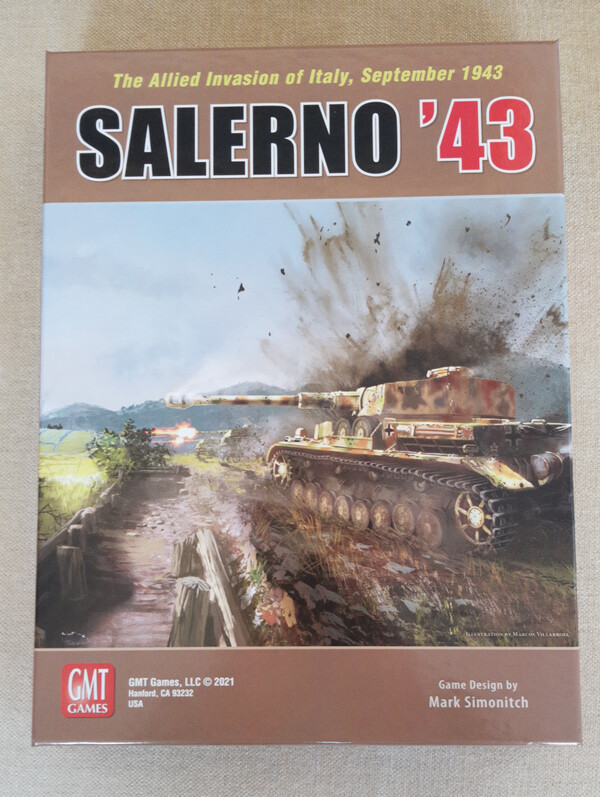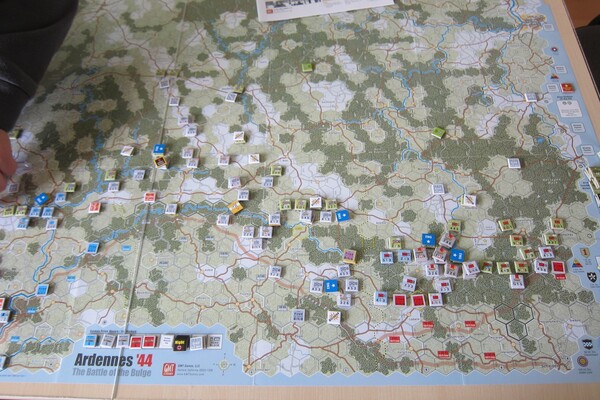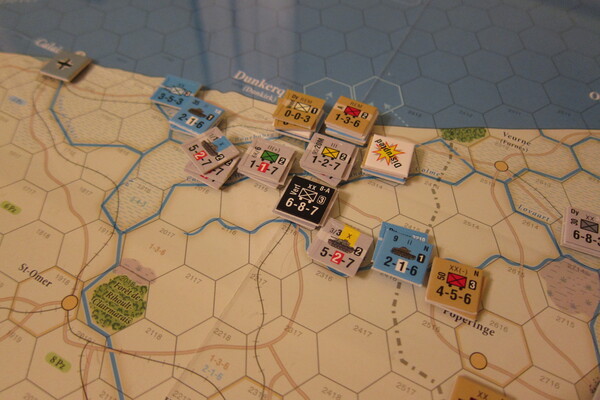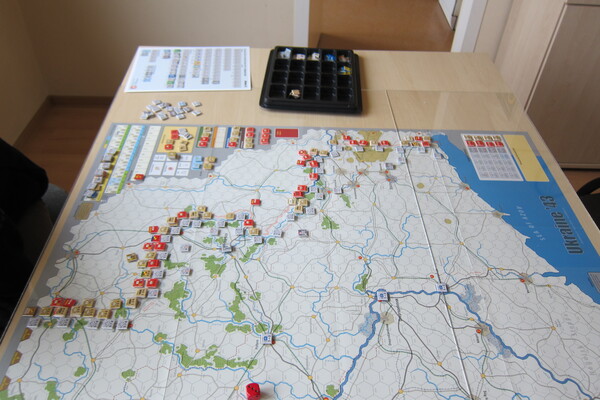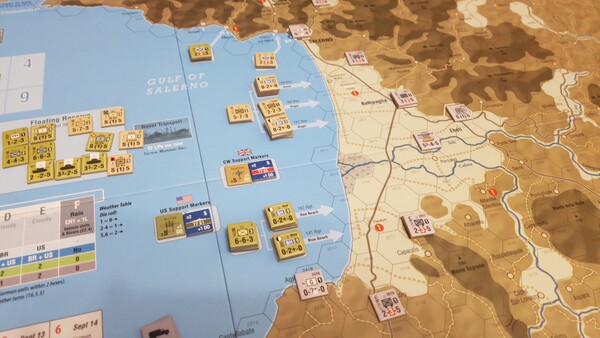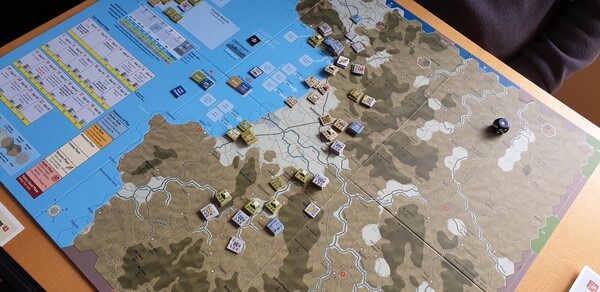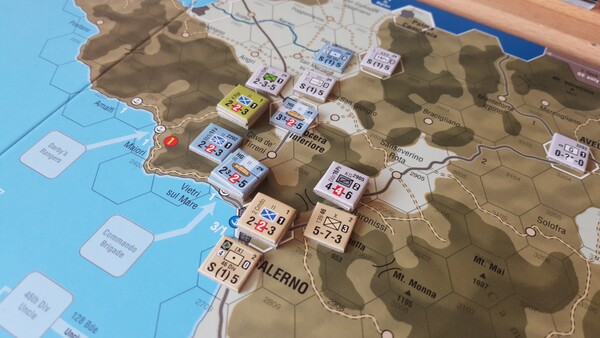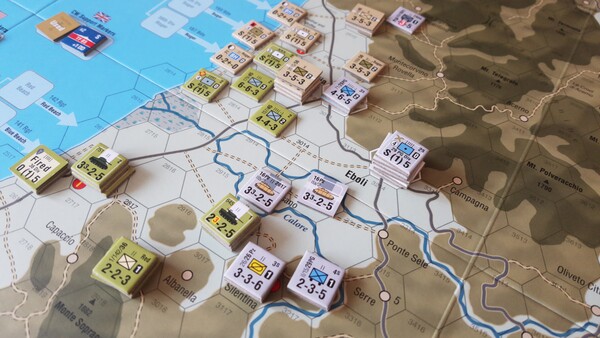Salerno ’43
In 2023 I finally managed to return to wargaming. This has been an important hobby of mine for well over a decade now, but I had few playing partners when I moved abroad. In the past 12 months I not only renewed several of my wargaming friendships, but also bought a new wargame for the first time in several years. My choice was Salerno ’43 published by GMT Games and designed by Mark Simonitch, a designer whose several games I have played in the past and was never disappointed with them.
Mark Simonitch is a designer specializing in World War II hex-and-counter games. His games typically focus on a single military operation lasting several weeks. His previous games include Ardennes ’44 (Battle of the Bulge in late 1944), Normandy ’44 (the Allied invasion of France, obviously), France ’40 (German invasion of Belgium and France as well as Dunkirk evacuation), Holland ’44 (Operation Market Garden), and several others.
The games often come with several scenarios, one of which is typically a shorter game that can be played in a couple of hours. Usually there’s also a longer campaign scenario, which might require more than one playing session to complete. Of course this isn’t a strict rule. For example both scenarios that come with France ’40 can be played in under 5 hours, which by wargaming standards makes for a short game. I personally lean towards these playing experiences that don’t exceed 5 hours. And so my attention was caught by Salerno ’43. It is a fairly recent design by Mark Simonitch and it plays on a very small map - again, by wargaming standards. This suggested a shorter and simpler game that has a chance of getting to the table more often than it’s larger siblings.
Salerno ’43 tells the story of Operation Avalanche, the Allied amphibious landing near the Italian city of Salerno in September 1943. One player assumes the role of the defending Germans, the other of the invading American and the British Commonwealth troops. So far I have only played the short scenario, which lasts eight turns and, once proficient with the rules, takes around 3 hours to play. There is also a 22-turn campaign scenario, which I am yet to try out. In all Mark Simonitch’s games the turns are constructed such that one player moves all his units, then conducts all combats, and then the other player gets their turn to do the same. Each player’s turn also contains various “bookkeeping phases”, when players receive reinforcements and check whether their units are in supply. The actual details are more complicated than that, but that’s the gist.
Speaking of simplicity, the game isn’t exactly as simple as I had hoped for. I mean, sure, the map is small. Just look:
Not only the map is 22” by 25.5”, instead of the usual 22” by 34”, but also over a third of the game board is covered by the sea. This makes the playing area small. The unit density is also fairly low, which is actually one of the trademarks of Mark Simonitch’s designs. The rules, however, are comparable in complexity to other, larger titles. One reason for this is the need to cover the naval invasion and provide mechanics for troops landing on the beaches. Another chunk of complexity is due to terrain in that area of Italy, which is mostly hills and mountains, with only a small pocket of plains south of Salerno. Then there’s a bunch of smaller rules to cover things like aerial and naval support, naval transport, weather, special units, or rare combat corner cases such as city battles. All that adds up to a game of rule complexity similar to previous designs, just with a smaller amount of counters and thus playing a bit faster. But not much faster if you haven’t internalized the rules and keep checking them in the rulebook.
An important question when discussing wargames is that of balance, i.e. do both sides have an equal chance of winning? Of course, when designing wargames that recreate historical battles this becomes tricky, since many campaigns have been single-sided. A good example of this is the already mentioned Operation Dynamo (Dunkirk evacuation) depicted in France ‘40. Historically, this has been a decisive German victory, though in the end the British managed to successfully retreat a significant number of the BEF soldiers. And so the game must recreate that historical imbalance of forces and outcomes, at the same allowing both players to achieve victory. Otherwise it wouldn’t be a fun game if one player was doomed to lose from the start. And so play balance is achieved by measuring players’ effectiveness against their historical counterparts, typically by assigning victory points (VPs) to certain strategic locations on the map, and then designing scenarios such that in order to win the players need to reach these locations in a given time frame.
Salerno ’43 uses this exact solution, but I am not entirely happy with the resulting gaming experience, at least in the short scenario. In order to win the Allied player must accumulate at least 8 VPs points by reaching designated objectives. Here’s how the objectives are laid out on the map - values in red circles are Victory Points:
I am yet to see a game where the Allies capture Eboli, Nocera Inferiore or anything north of it. I imagine this could be possible with a combination of lucky die rolls or German player incompetence, but in the games I played so far the Allies weren’t even able to approach any of these cities, let alone attempt to capture them. The remaining objectives total at exactly 8 VPs, leaving the Allies no room for any strategic decision making. I also note that VPs can be gained or lost by eliminating certain critical units such as artillery or beachheads. Artillery losses don’t really happen, but unlucky die rolls can result in losing a beachhead. In fact same goes for Salerno - it has to be captured by the Rangers and Commandos on turn one. If that fails, capturing it later becomes nearly impossible. In other words, with unlucky die rolls on the first turn leading to not capturing Salerno the fate of the Allied player is practically sealed.
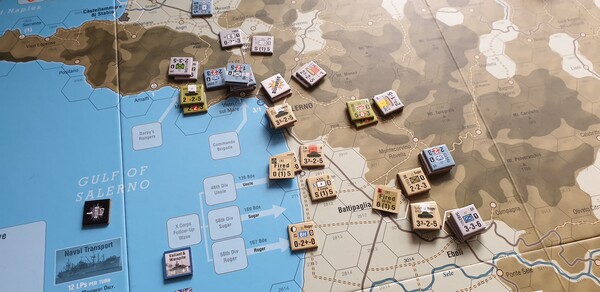
That being said, while there isn’t much room for larger strategic decisions in the short scenario, there are tons of smaller tactical decisions to be made. And while the broad picture of the invasion was similar in all the games I played so far, at a tactical level all the games were completely different. There’s lots of manoeuvring to get units into favourable positions, which is crucial given the amount of hills and rivers. On that front the game absolutely delivers, requiring the player to think a lot about how to best utilize available assets, and demanding some really difficult decisions.
All in all, I did enjoy my games of Salerno ’43. The game isn’t as simple in terms of rules as I hoped it will be, but small playing area and low unit count makes for a quick wargaming experience. I also note that history buffs will spot some minor simplifications that could be seen as historical inaccuracies. I personally find these absolutely irrelevant.
